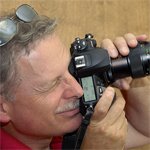I always review the science behind photography to better understand - or just figure out - whatever I'm attempting to do. To condense the specifics behind grayscale conversions, first we need a little background about conversion to Grayscale from RGB...
What is RGB? What is Grayscale?
RGB is nothing more than three separate channels of 256-step, 8-bit grayscale images taken through a Red, Green and Blue filter overlaying the sensor in your DSLR. Each one records a different luminance range depending on the subject colors as they pass through the RGB filtration. Look at an RGB image in the Channels pallette in Photoshop and you'll see what I mean. None make an ideal grayscale...
Grayscale, in the purest sense, is a 256-step, 8-bit image - that's all. Those of us in the graphic design field refer to these as halftones when printed in black ink only. They have real limitations in representing all the tones of an original image and that has fomented the development of duotones, tritones and quadtones in the traditional history of lithography (printing). But I digress...
Downsampling a three-channel RGB image into a 256-step single channel image renders a pure black-and-white image - the trick is getting a pleasing or accurate representation of the scene. Traditionally, we have seen folks (1) simply desaturate an RGB image and yank Contrast, Brightness and Exposure controls with abandon to achieve their desired effects. Then, an 'educated' way to render a grayscale emerged by moving the image into LAB space and singling out the L channel for a clean, neutral grayscale image. That's true, it is, but now you have 1/3 of the data and a significantly smaller printing file to work with. You can see why we hear so much talk about this subject...
RGB to Grayscale Advantages
Keep an image in RGB makes sense in two ways - image control and file size. You want to keep both, right? Modern output devices are so handy that downsampling to a single channel of information is practically foolish - alright, it is - really. Software can create a superb grayscale rendition in so many ways that an RGB image shouldn't be viewed as a color file exclusively. It's application in grayscale conversions is practically unlimited - and its color data is the secret ingredient.
Photoshop vs. Lightroom
Photoshop's Channel Mixer allows for varying the levels of each RGB channel to maximize the potential of the original color image. When converting to a grayscale, this tool can individually alter the luminance of each channel, significantly altering its appearance to meet your personal criteria. But, being a little long in the tooth these days, it's limited controls are becoming apparent.
Lightroom 1.1's 'conversion' tools actually exceed Photoshop's with eight color sliders versus PS's three. Unique to LR is its ability to affect temperature and provide an Auto-Adjust after each adjustment - providing a much wider range of control. Warming and cooling the color areas produces big differences in grayscale rendering and will help you achieve a pleasing conversion with practice. Split Toning allows for highlight and shadow colorations for even greater nuances. With Lightroom, you have serious grayscale conversion software at your command.
Today, it is commonplace to leave your grayscale conversion in the RGB color space at the output stage - this gives greater depth and richness to the tones and allows for 'colorizing' in sepia and other tones. Or mixing color areas with grayscale areas - common in wedding images.
Any way you look at it, grayscale conversions are being made better with the new tools in Lightroom 1.1!
Mule
Wednesday, September 5, 2007
Subscribe to:
Post Comments (Atom)



3 comments:
Im an aspiring photographer... I would like to learn a lot... But just started with my basics. can you please help me in knowing the relationship between aperture and shutter speed.
Also I have posted a few photographs on my blogs. Can you please let me know how I can improve on these...??
Thanks in advance..
Aperture relates to f-stop openings in the lens that the light passes through. The f-stops on your lens are made smaller by turning to the higher numbers and smaller with the larger numbers - go figure that!
Shutter speeds simply halve and double as they are moved up and down the range available on your camera - 1 sec, 1/2, 1/4, 1/8, 1/15, 1/30, 1/60, 1/125, etc.
If a correct exposure can be made at f8 at 1/160th, a similar exposure can also be made at f5.6 @ 1/125th or f11 @ 1/30th. Halving and doubling the aperture/shutter speed combination will render the same exposure.
That's the exposure mechanics of all cameras in a nutshell. Setting your DSLR on S or A mode will demonstrate this relationship as you alter one setting and watch the other move in relation to it.
So which f-stop should you use? They control depth of field (DOF), and you will have greater DOF as you 'stop down' toward the smaller apertures and less as you 'open up' toward the larger apertures.
Play with that concept for a while and see what you learn - hope it helps!
Post a Comment